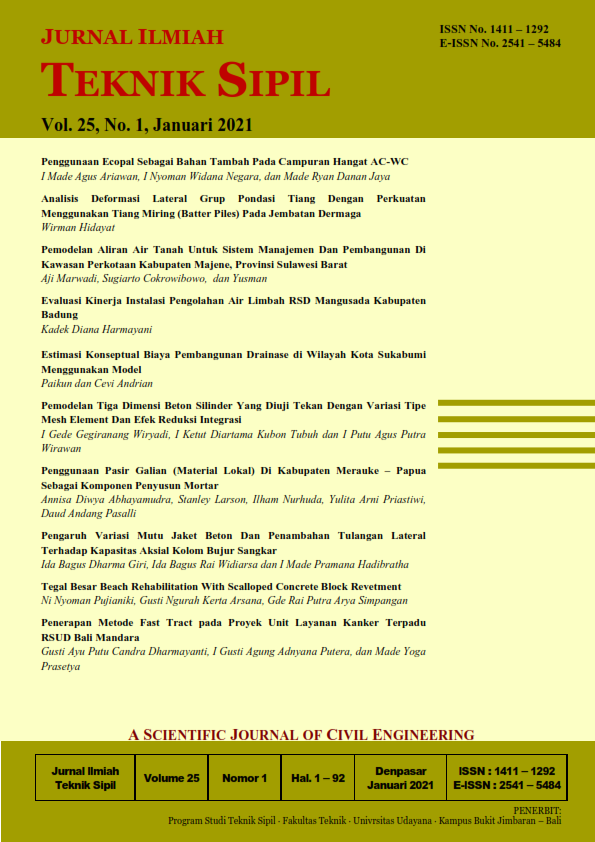PENGGUNAAN PASIR GALIAN (MATERIAL LOKAL) DI KABUPATEN MERAUKE – PAPUA SEBAGAI KOMPONEN PENYUSUN MORTAR
Abstract
Pembangunan infrastruktur oleh Pemerintah Indonesia dilakukan salah satunya di Kabupaten Merauke. Namun, ketersediaan material dengan mutu tinggi harus didatangkan dari luar Merauke yang mengakibatkan harganya mahal dan waktu pengiriman yang lama. Bahan konstruksi alternatif terus dicari dan dikembangkan seperti penggunaan material lokal. Tujuan dari penelitian ini untuk mengetahui pasir manakah yang terbaik sebagai bahan campuran mortar. Penelitian mortar ini menggunakan 3 (tiga) pasir dari quarry di Merauke yaitu Onggari-1, Bupul-5, dan Senayu tanpa koreksi. Perbandingan penyusun mortar antara semen dan pasir adalah 1:2 dengan FAS 0,4, dengan benda uji berupa kubus 5x5x5 cm. Properties dari masing-masing pasir saat kondisi asli diuji sedangkan pengujian kuat tekan mortar dilakukan pada umur 8 hari, 14 hari dan 28 hari. Mortar juga diuji berat volume, berat jenis, dan penyerapan air nya. Hasil analisis menunjukkan bahwa Onggari-1 memenuhi sebagian besar spesifikasi properties untuk pasir beton dengan kadar lumpur kurang dari 5%, kotoran organisnya rendah dan gradasi well-graded. Kuat tekan yang dicapai Onggari-1 merupakan kuat tekan tertinggi sebesar 38,45 MPa, diikuti Senayu sebesar 26,01 MPa dan Bupul-5 sebesar 19,44 MPa pada umur 28 hari. Pasir galian dari quarry Senayu dan Bupul-5 perlu dilakukan treatment berupa pencucian pasir dan perbaikan gradasi pasir. Secara keseluruhan, semua pasir dapat digunakan untuk pekerjaan pasangan struktur yang memikul beban besar seperti dinding eksterior maupun interior.
Downloads
References
Arooz, & Halwatura. (2018). Mud-Concrete Block (MCB): Mix Design & Durability Characteristics. Case Studies in Construction Materials, 9,
ASTM Standard. (2003). Standard Specification for Concrete Aggregates (ASTM C33-03). West Conshohocken, USA: ASTM International.
ASTM Standard. (2013). Piece Density by Mercury Displacement (ASTM UOP766-13). West Conshohocken, USA: ASTM International.
ASTM Standard. (2015). Standard Test Method for Rate of Water Absorption of Masonry Mortars (ASTM C1403). West Conshohocken, USA: ASTM International.
Badan Standardisasi Nasional. (2002). Metode Pengujian Kekuatan Tekan Mortar Semen Portland Untuk Pekerjaan Sipil (SNI 03-6825-2002). Jakarta, Indonesia: Departemen Pekerjaan Umum.
Badan Standardisasi Nasional. (2016). Spesifikasi agregat beton (ASTM C33/C33M - 13, IDT) (SNI 8321:2016). Jakarta, Indonesia: Departemen Pekerjaan Umum.
Chhaba, S., & Singh, C. (2017). Performance of Mud Brick in Building Construction System. International Journal of Engineering Technology and Computer Research, 4, 128-132.
Halim, A., & Prawono, S. (2015). Pengaruh Campuran Semen Dalam Pembuatan Soil Cement Column Pada Tanah Margomulyo-Surabaya. Jurnal Dimensi Pratama Teknik Sipil, 4, 1–7.
Pasalli, D. A. (2012). Sifat-Sifat Mortar Dari Pasir Merauke di Kabupaten Merauke-Papua. Jurnal Ilmiah Mustek Anim Ha, 1.
Pasalli, D. A. (2014). Karakterisitik Beton Non Struktur dari Bahan Lokal di Distrik Muting Merauke Perbatasan Republik Indonesia-Papua Neugini. Jurnal Ilmiah Mustek Anim Ha, 3, 122-137.
Sheweka, S. (2011). Using Mud Bricks as a Temporary Solution for Gaza Reconstruction. Energy Procedia, 6, 236-240.
Yasin, B., Said, L., & H, M. (2018). Analisis Ketebalan Dan Komposisi Pada Konstruksi Soil Semen (Studi Kasus : Pt Elevasi Sagarmatha - Merauke). 1, 81-87. Retrieved from http://mtsumi.ac.id/magistertekniksipil.html





